Bucharest Metro
The Bucharest Metro (Romanian: Metroul București) is an underground rapid transit system that serves Bucharest, the capital of Romania. It first opened for service on 16 November 1979.[5] The network is run by Metrorex. One of two parts of the larger Bucharest public transport network, Metrorex has an average of approximately 720,000 passenger trips per weekday (as of 2018),[4] compared to the 1,180,000 daily riders on Bucharest's STB transit system.[6] In total, the Metrorex system is 77.53 kilometres (48.2 mi) long and has 63 stations.[1][3]
| Transport in Romania |
|---|
| Companies |
History
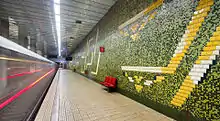
The first proposals for a metro system in Bucharest were made in the early part of the 20th century, by the Romanian engineers Dimitrie Leonida and Elie Radu.[7]
The earliest plans for a Bucharest Metro were drafted in the late 1930s, alongside the general plans for urban modernization of the city.[8] The outbreak of World War II, followed by periods of political tensions culminating with the installation of communism, put an end to the plans.[9]
By 1970, the public transport system (ITB) was no longer adequate due to the fast pace of urban development, although the system was the fourth-largest in Europe. A commission was set up, and its conclusion pointed to the necessity of an underground transit system that would become the Bucharest Metro. The plan for the first line was approved on 25 November 1974 as part of the next five-year plan and the construction on the new metro system started on 20 September 1975.[10]
The network was not built in the same style as other Eastern European systems.[7] Firstly, the design of the stations on the initial lines was simple, clean-cut modern, without excessive additions such as mosaics, awkward lighting sources or excessive decoration. The main function of the stations was speed of transit and practicality. Secondly, the trainsets themselves were all constructed in Romania and did not follow the Eastern European style of construction.[11] Each station usually followed a colour theme (generally white – in Unirii 2, Victoriei 1, Lujerului; but also light blue – in Obor, Universitate, and Gara de Nord; orange – in Tineretului; green - in Grozăvești), and an open plan. No station was made to look exactly like any other. Despite this, many stations are rather dark, due to the policies of energy economy in the late 1980s, with later modernisations doing little to fix this problem. Bucharest being one of the largest cities in the region, the network is larger than those of Prague or Budapest. When the planned new line-extensions are finished, they will increase the system length to more than 100 km, with about 80 stations.
The first line, M1, opened on 19 November 1979, running from Semănătoarea (now Petrache Poenaru) to Timpuri Noi.[5] It had a length of 8.1 kilometres (5.0 mi) with 6 stations.[5] Following this, more lines and several extensions were opened:[11][12]
- 28 December 1981: M1 Timpuri Noi – Republica; 9.2 kilometres (5.7 mi), 6 stations
- 19 August 1983: M1 (now M3) Branch line Eroilor – Industriilor (now Preciziei) ; 8.2 kilometres (5.1 mi), 4 stations (Gorjului added later)
- 22 December 1984: M1 Semănătoarea (Petrache Poenaru) – Crângași; 0.97 kilometres (0.60 mi), 1 station
- 24 January 1986: M2 Piața Unirii – Depoul IMGB (now Berceni) ; 9.96 kilometres (6.19 mi), 6 stations (Tineretului and Constantin Brâncoveanu added later)
- 6 April 1986: M2 Tineretului; 1 infill station
- 24 October 1987: M2 Piața Unirii – Pipera; 8.72 kilometres (5.42 mi), 5 stations (Piața Romană added later)
- 24 December 1987: M1 Crângași – Gara de Nord 1; 2.83 kilometres (1.76 mi), 1 station (Basarab added later)
- 28 November 1988: M2 Piața Romană; 1 infill station
- 5 December 1988: M2 Constantin Brâncoveanu; 1 infill station
- 17 August 1989: M3 (now M1) Gara de Nord 1 – Dristor 2; 7.8 kilometres (4.8 mi), 6 stations
- May 1991: M1 Republica – Pantelimon; 1.43 kilometres (0.89 mi), 1 station (single track, operational on a special schedule)
- 26 August 1992: M1 Basarab; 1 infill station
- 31 August 1994: M3 Gorjului; 1 infill station (westbound platform only; eastbound platform opened in 1998)
- 1 March 2000: M4 Gara de Nord 2 – 1 Mai; 3.6 kilometres (2.2 mi), 4 stations
- 20 November 2008: M3 branch Nicolae Grigorescu 2 – Linia de Centură (now Anghel Saligny), 4.75 kilometres (2.95 mi), 4 stations
- 1 July 2011: M4 1 Mai – Parc Bazilescu, 2.62 kilometres (1.63 mi), 2 stations
- 31 March 2017: M4 Parc Bazilescu – Străulești, 1.89 kilometres (1.17 mi), 2 stations[13]
- 15 September 2020: M5 Raul Doamnei / Valea Ialomitei – Eroilor 2, 6.87 kilometres (4.27 mi), 10 stations[14]
Lines M1 and M3 have been sharing the section between Eroilor and Nicolae Grigorescu.
Large stations which connect with other lines, such as Piața Victoriei, have two terminals, and each terminal goes by a different name (Victoriei 1 and Victoriei 2). On the official network map, they are shown as two stations with a connection in between, even though, in fact - and for trip planners - they are a single station with platforms at different levels. There is one exception: Gara de Nord 1 and Gara de Nord 2 are separate stations (although linked through a subterranean passage, the traveller is required to exit the station proper and pay for a new fare at the other station, thus leaving the system), passengers being required to change trains at Basarab.
Generally, the underground stations feature large interiors.[10] The largest one, Piata Unirii, is cathedral-like, with vast interior spaces, hosting retail outlets and fast-food restaurants and has an intricate network of underground corridors and passageways.
Metrorex
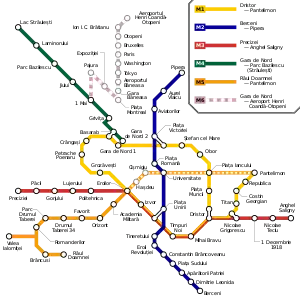
.jpg.webp)
Metrorex is the Romanian company which runs the Bucharest Metro. It is fully owned by the Romanian Government through the Ministry of Transportation. There were plans to merge the underground and overground transportation systems into one authority subordinated to the City of Bucharest, however these plans did not come to fruition.
Infrastructure and Network
Starting in 2018, the entire network runs underground, except for a short stretch between Dimitrie Leonida and Berceni stations on the southern end of the M2 line. The network is served by six depots, two being located above ground (IMGB and Industriilor) and four underground (Ciurel, Străulești, Pantelimon and Valea Ialomitei) and smaller additional works at Gara de Nord and Eroilor stations.
There are two connections between the Metro network and the Romanian Railways network, one at Berceni (connecting to the Bucharest Belt Ring), the other at Ciurel (connecting via an underground passage to the Cotroceni-Militari industrial railway). The latter connection however is unused and mothballed. The metro network and the national rail network share the same track gauge (1,435 mm / 4 ft 8 1⁄2 in) and loading gauge but not the same electrification system (the metro uses 750 V DC whereas the Romanian Railways use 25,000 V 50 Hz AC) making it possible for new metro cars to be transported cross country as unpowered railway cars.
The network is powered by a bottom-contact third rail system except in works, depots and some tunnels where a catenary system is employed.
Lines
There are 5 metro lines in operation, and another 1 in the planning phase:
Line Opened Last
expansionTrack length[3][15] Headway[1] operational under construction planned off-peak rush hour M1 November
1979August
199231.01 km — — 7–9 minutes
(4 minutes between Eroilor and Nicolae Grigorescu)3–6 minutes
(3–3.5 minutes between Eroilor and Nicolae Grigorescu)M2 January
1986October
198718.68 km 1.6 km 1.6 km 4–7 minutes (weekdays off peak hours)
7–9 minutes (weekends, late nights)1–3 minutes M3 August
1983November
200813.53 km
+ 8.67 km (M1)— — 7–9 minutes
(4 minutes between Eroilor and Nicolae Grigorescu)3–6 minutes
(3–3.5 minutes between Eroilor and Nicolae Grigorescu)M4 March
2000March
20177.44 km — 10.6 km 8–10 minutes 7 minutes M5 September
2020— 6.87 km — 9.2 km 18 minutes (on each branch)
9 minutes (between Eroilor and Romancierilor)12 minutes (on each branch)
6 minutes (between Eroilor and Romancierilor)M6 2025-2030 — — — 14.2 km N/A Total 77.53 km 1.6 km 35.6 km
- M1 Line: between Dristor and Pantelimon – the first line to open in 1979, last extension in 1990; it is circular with a North-Eastern spur. Part of its tracks are shared with M3 (7 stations).
- M2 Line: between Pipera and Berceni opened in 1986, last extension in 1987; it runs in a North-South direction, crossing the center.
- M3 Line: between Preciziei and Anghel Saligny opened in 1983, last extension in 2008; it runs in an East-West direction, south of the center. Shares part of its tracks with M1 (7 stations).
- M4 Line: between Gara de Nord and Străulești opened in 2000, last extension in 2017.
- M5 Line: between Râul Doamnei and Eroilor opened in 2020; it runs through the Drumul Taberei neighborhood.
Signalling system
There are multiple signalling systems used. Line 2, the first one that has been modernized, uses Bombardier's CITYFLO 350 Automatic Train Control system. It ensures the protection (Automatic Train Protection) and operation (Automatic train operation) of the new Bombardier Movia trains.
The system uses an IPU (Interlocking processing unit), TI21-M track circuits and EbiScreen workstations. Signals have been kept only in areas where points are present, but only use a white light, meaning that the route has been assigned and the driver can use cab signalling. Trains are usually operated automatically, with the driver only opening and closing the doors and supervising the operation. Other features include auto turnback and a balise system, called PSM (precision stop marker). This ensures that the train can stop at the platform automatically.
On line 3, the ATC system has been merged with the Indusi system. Signals are present in point areas and platform ends. Along with the three red-yellow-green lights, the white ATP light has been added. Optical routes can be assigned, meaning that a train gets a green light (permission to pass the signal) only after the next signal has been passed by the train ahead, or a yellow light, meaning that the signal can be passed at low speed. Automatic Block signals have been removed.
Line 4 uses Siemens's (formally Invensys Rail Group) TBS 100 FB Automatic Train Control system.
Line 5 will use Alstom's Urbalis 400 Communications-based train control system.
Hours of operation
Trains run from 5 AM to 11 PM, every day. The last trains on M1, M2 and M3 wait for the transfer of the passengers between lines to complete, before leaving Piața Unirii station.[16]
Headway
At rush hour, trains run at 4–6-minute intervals on lines 1 and 3, 1-3 minute intervals on line 2, and at 7–8-minute on line 4; during the rest of the day, trains run at 8-minute intervals on lines 1 and 3, 7-9 minute intervals on line 2 and 10-minute intervals on line 4.[1]
Fares and tickets
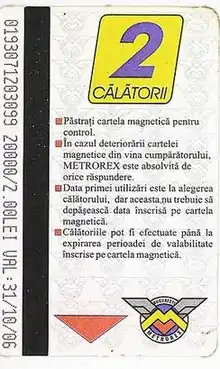
Public transport in Bucharest is heavily subsidized, and the subsidies will increase, as the City Council wants to reduce traffic jams, pollution and parking problems and promote public transport. Like the STB, the metro can get crowded during morning and evening rush hours. The network uses magnetic stripe cards, that are not valid for use on trams, buses or trolleys . Payment by contactless credit cards is available directly at the turnstiles. One tap will take 2.5 RON, the equivalent of one trip. For multiple validations with the same card, tap the plus button.
Magnetic stripe cards
Older style metro cards can be purchased at any metro station, except discounted passes, which can only be purchased at a limited number of stations. Prices :[17]
- 1 trip Integrated Metro and STB (Bus, tram, trolleybus) ticket; valid for 60 minutes after first use - 5 RON - Not to be used on express or regional bus lines.
- 10 trip Integrated Metro and STB (Bus, tram, trolleybus) ticket; valid for 60 minutes for each trip - 34 RON - Not to be used on express or regional bus lines.
- 1-trip card – 2.50 lei
- 2-trip card – 5 lei (€1.13)
- 1-day card – 8 lei (€1.80)
- 10-trip card – 20 lei (€4.52)
- Unlimited weekly pass (full price) – 25 lei (€5.65)
- Unlimited monthly pass (full price) – 70 lei (€15.82)
- Unlimited student monthly pass (available for students in Romanian universities) – 35 lei (€7.91)
- Free for senior citizens over 70 years of age
Older-style metro cards are not linked with personal data or usage data in a central database and thus they guarantee anonymity of the travel. Because of that, however, if a metro card is lost or damaged, the traveler cannot be reimbursed for the unused trips.
Future service
Under construction
- M2 Line southbound extension (1.6 km (1.0 mi)):[2]
- Tudor Arghezi station from Berceni to the Bucharest South Ring Road;
Planned
- M2 Line: a further northbound extension of 1.6 km (1.0 mi) and two more stations from Pipera;[18]
- M4 Line extension: between Gara de Nord, through Soseaua Giurgiului and ending at Gara Progresul at Bucharest' southern limit , this section is in a very early planning phase;[19]
- M5 Line: a further extension of 9.2 km (5.7 mi) to Pantelimon is approved;[20]
- M6 Line: between Gara de Nord and Henri Coandă International Airport.[3]
Other proposals
Metrorex is also planning the following new lines, routes and stations:
- Line M7; it is supposed to run 25 kilometres (16 mi) from Bragadiru to Voluntari.[21]
- Line M8, the south half ring. Its route has not been fully planned yet, but it will run through Piața Sudului and end at Crângași and Dristor stations.
- An extension of the Line M3 is also planned for 2030.[22]
- Two more stations are planned and may be constructed on existing lines, both on M1. However, given the complexity of work required, and the limited benefits these stations would have it is unlikely that construction will begin in the near future:
- Dorobanți between Stefan cel Mare and Piața Victoriei;
- Giulești between Crângași and Basarab.
Rolling stock
The Bucharest Metro uses three types of trainsets:[1][23]
- Astra IVA – 31 trainsets (186 cars), built between 1976 and 1992, of which 15 trainsets (90 cars) modernised by Metrorex and Alstom Transport România in 2011-2013,[3] used on M3 and M4;
- Bombardier Movia 346 – 44 trainsets (264 cars), built between 2002 and 2008, used on M1, M2, M3 and M5;
- CAF - 24 trainsets (144 cars), built between 2013 and 2016, used on M2.
| Vehicle | Type and description | Interior |
|---|---|---|
 |
The Romanian designed Astra IVA trains, built in Arad, are made up of various trainsets (rame) connected together. Each trainset is made up of two permanently connected train-cars (B'B'-B'B' formation) that can only be run together. The Astra IVA rolling stock is approaching the end of its service life, so it is gradually being phased out. They are used on the Bucharest Metro Lines M3 and M4. | 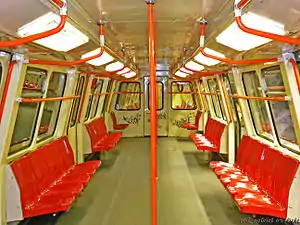 |
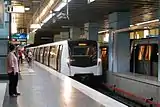 |
The Bombardier Movia 346 trains are made up of six permanently connected cars, forming an open corridor for the entire length of the train (2'2'+Bo'Bo'+Bo'Bo'+Bo'Bo'+Bo'Bo'+2'2' formation). Bombardier trains are used on all lines, except line M4. |  |
 |
In November 2011, Metrorex signed a €97 million contract with CAF for 16 metro trains (96 cars), with options for a further 8 sets (48 cars).[24] The 114m-long six-car trains will be assembled in Romania. They each accommodate up to 1,200 passengers and are made up of four powered and two trailer vehicles. As of November 2014, all trains have been delivered and all 16 of them entered in service. As the CAF trains enter service, all of the Bombardier stock will be moved for use on line M3, according to Metrorex's plans to replace all of the old Astra IVA stock on the entire network.
In November 2014, Metrorex signed an additional €47 million contract with CAF for 8 metro trains. As of 2018, 24 CAF trains are in use, exclusively on line M2. |
 |
The subway livery for Bucharest is either white with two yellow or red horizontal stripes below the window for the Astra trains, stainless steel with black and white for the Bombardier trains, or stainless steel with blue and white for the CAF trains.
All trains run on a 750 V DC third rail, or an overhead wire (in maintenance areas where a third rail would not be safe). Maximum speed on the system is 80 km/h (50 mph), although plans are to increase it to 100 km/h (60 mph) on M5, a new line currently under construction.
Incidents
In its almost 40 years of operations, there never have been very grave accidents, however, there have been various incidents, either during construction or operation. Accidents are investigated by the Railway Investigation Authority (Agenția de Investigare Feroviară Română (AGIFER)).
- 1983: Due to works on M2, the Piața Unirii 1 station was flooded by the Dâmbovița.
- 1986, April or May: Whilst digging for a connection service tunnel for the M1-M2 lines, the foundations and altar of the Slobozia Church were cracked, leading to the subsequent closure of the construction site of the tunnel, which was filled with sand. Thus, trains for the M2 were disconnected from the rest of the network up to 1987 (trains were sent through the Bucharest Freight Railway Bypass), when another link tunnel was created at Piața Victoriei.
- 1987, 1 May: During reconstruction work at Piața Unirii, the Dâmbovița was breached again, this time flooding both stations and forcing train circulation to cease for the next 5 days as a result. The flooding took place during a heavy rainstorm and during work on the Unirii Underpass (which was opened on 6 June 1987, after a record 34 days of work), when an excavator damaged a collecting canal of the Dâmbovița, flooding the underpass construction site, and subsequently, the M1 station. The M2 metro station was flooded due to an improperly sealed tube, designed for electric installations. At its peak, the flooding was 30 centimeters over the platforms, but further damages to the electrical transformers were avoided.
- 1987, 2 May: During recovery from the flooding at Piața Unirii the previous day, the tunnel between Timpuri Noi and Mihai Bravu was found fully submerged by the Dâmbovița, possibly in relation to the previous incident. Signalling and other electrical cables were damaged, which further prolonged the repair efforts for the previous incident.
- 2010, 17 November: An IVA train derailed between Timpuri Noi and Piața Unirii.
- 2015, 14 January: Due to a broken pipe, a fire started out at Tineretului station, leading to its closure for the rest of the day.
- 2016, 14 June: Piața Victoriei was closed after huge amounts of smoke originated from the third rail.
- 2017, 20 January: A fire, originating from electrical contactors, led to the evacuation of the Universitate station, subsequently leading to the closure of one of the tracks towards Piața Unirii.
- 2018, 16 August: A train in Piața Unirii had to be evacuated, after someone began pepper-spraying the consist stopped in the station.
- 2019, 26 January: A newly-purchased CAF unit crashed in the Berceni depot. The train, which was stabled outside, was being shunted into the depot to prevent icing, however, due to software failure, it could not stop on time and crashed past the buffers. It is likely that the train could be scrapped since there is no way to remove it.
Aside from these incidents, there have been other disruptions, especially in the last 3 years, due to suicides at the metro. A recent one on 25 June 2019, lead to the disruption of metro traffic at rush hour between Piața Unirii and Eroilor (the suicide took place at Izvor). Aside from that, in 2017, one woman was arrested for pushing a person in front of a train. These incidents led to criticism of METROREX, and suggestions to install platform screen doors or to increase security. Additionally, railfans reported harassment from security guards, being told "not to photograph in the stations", despite there being no official rule prohibiting photography in the metro network.
Facts
Bucharest Metro was the only one in the world that operated with passengers during testing.[25]
In the 1980s, the speed of building the network (4 kilometers / year) placed the Bucharest Metro on the second place in the world, after Mexico City Metro.[26]
The shortest distance between two adjacent stations is between Gara de Nord 2 (M4) and Basarab 2 (M4) and is 430 meters.
Network Map
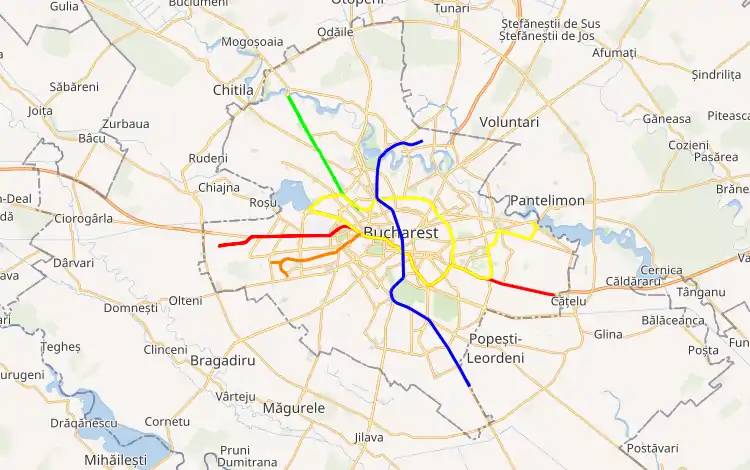
See also
References
- "Metrorex - Network features". Metrorex. Retrieved 9 August 2019.
- "Lucrări începute la stația supraterană pe magistrala de metrou M2 în Berceni". 18 January 2021.
- "Reţeaua de metrou în funcţiune (2018). Detalii M1, M2, M3, M4 la pg.6 și M5 la pg.46" (PDF). Metrorex.ro. Retrieved 17 September 2020.
- Timpul de aşteptare la metrou, neschimbat de cinci ani
- "Metrorex - Metrorex history". Metrorex. Retrieved 8 May 2014.
- Cand se va circula la standarde europene
- "30 de ani de exploatare a metroului bucurestean" (in Romanian). agir.ro. August 2009.
- "Metroul bucureștean, 10 lucruri pe care ar trebui să le cunoști" (in Romanian). historia.ro. Retrieved 29 July 2014.
- "Bucureștiul mileniului trei imaginat în 1930" (in Romanian). cotidianul.ro. Retrieved 29 July 2014.
- "Ce nu știați despre metroul bucureștean: De la planurile din 1909, la Magistrala 7" (in Romanian). 19 November 2012. Retrieved 29 July 2014.
- Bucharest Metro at urbanrail.net
- "Istoric Metroul bucureștean" (in Romanian). metroubucuresti.webs.com. Archived from the original on 9 August 2014. Retrieved 29 July 2014.
- "Metrorex a deschis circulatia in statiile de metrou Laminorului si Straulesti" [Metrorex opened circulation in the Laminorului and Straulesti metro stations] (Press release) (in Romanian). Metrorex S.A. 31 March 2017. Retrieved 30 January 2021.
- "Linia de Metrou Magistrala 5" [Metro Line M5]. www.metrorexm5.ro (in Romanian). Metrorex S.A. Retrieved 30 January 2021.
- "Magistrala 5: Secțiunea Râul Doamnei – Eroilor (PS Opera) inclusiv Valea Ialomiței (6,871 Km)". Metrorex S.A. Retrieved 16 September 2020.
- "Metrorex - Schedule". Metrorex. Retrieved 7 May 2014.
- "Metrorex - Fees". Metrorex. Retrieved 7 May 2014.
- "MT va solicita finantare UE pentru Magistrala Berceni-Pipera". 17 May 2018.
- "Companies tendered for prefeseability studies for M4 extension". 1 September 2017.
- In ce stadiu este proiectul metroului pana la Pantelimon si cand ar putea fi gata? (in Romanian)
- "Bucuresti metro expansion tendering". Railway Gazette. 22 February 2011. Retrieved 27 February 2011.
- Ignat, Vlad. "Păianjenul Metrorex schimbă harta Capitalei. Bucureștenii se mută în subteran, din 2030" [Metrorex's Web Project changes the map of Bucharest. Bucharest moves underground by 2030]. Adevărul (in Romanian). Retrieved 7 May 2014.
- În cele mai noi stații de metrou vor circula cele mai vechi trenuri Metrorex (in Romanian)
- CAF Info cars
- "Metroul din București, singurul din lume care a funcționat cu călători în perioada de probe | Bucurestii Vechi si Noi". www.bucurestiivechisinoi.ro (in Romanian). Retrieved 7 July 2018.
- Juncu, Diana. "10 lucruri pe care nu le știai despre metroul bucureștean". OBSERVATOR.TV. Retrieved 7 July 2018.
External links
| Wikimedia Commons has media related to Bucharest Metro. |
- Metrorex - official site
- 2015 Activity Report
- Interactive subway map (in Romanian)
- Bucharest Metro Track Map (in Russian)
- Bucharest Metro Challenge
- Bucharest Subway info
- Bucharest Metro, practical map
- Map of future lines
- Bucharest Metro Map


